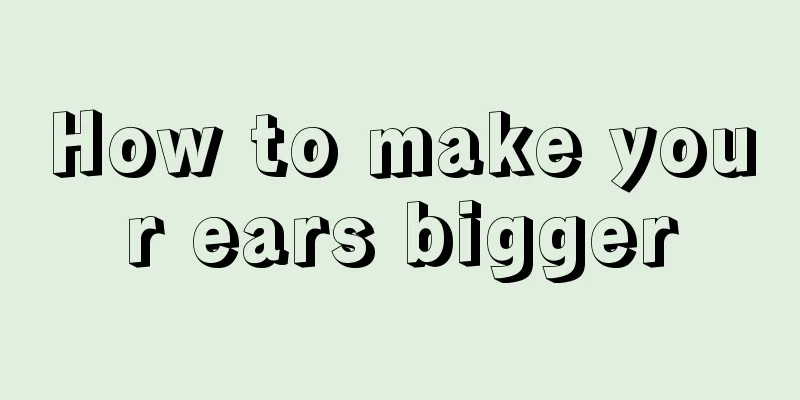How to make your ears bigger

|
There is a saying that goes "Big feet allow you to walk everywhere, and big ears allow you to hear everything." Of course, maybe hearing and ear size are not closely related, but ears that are too small will affect the coordination of facial features. Most people have normal ears, but a small number of people have deformed ears. However, the deformities can be corrected in early childhood. So how can we make ears that look normal but are relatively small in size bigger? structure The ear is located behind the eye. It has the function of distinguishing vibrations and converting the sound produced by the vibrations into nerve signals, which are then transmitted to the brain. In the brain, these signals are translated into words, music, and other sounds that we can understand. In anatomy, the ear consists of three parts: the outer ear, the middle ear, and the inner ear. The outer ear includes: Auricle: The auricle has the function of gathering and reflecting waves. External auditory canal: It is about 2.5-3.5CM long and consists of cartilaginous part and bony part. The cartilaginous part occupies about the outer 1/3 of it. There are two narrow places in the external auditory canal, one is the junction of the bony and cartilaginous parts, and the other is the bony part about 0.5CM away from the tympanic membrane. The latter is called the external auditory canal isthmus. The external auditory canal is S-shaped. There is very little subcutaneous tissue in the external auditory canal, and the skin is almost in contact with the perichondrium and periosteum. Therefore, when infected and swollen, it is easy for nerve endings to be compressed and cause severe pain. The skin in the cartilaginous part contains cerumen glands with a structure similar to sweat glands that can secrete cerumen, and is rich in hair follicles and sebaceous glands. Nerves and blood vessels of the external auditory canal: One is the auricular branch of the mandibular nerve, which is distributed in the front half of the external auditory canal, so pain from dental disease can be transmitted to the external auditory canal; the other is the auricular branch of the vagus nerve, which is distributed in the back half of the external auditory canal, so when the skin of the external auditory canal is stimulated, it can cause reflex coughing. There are also branches from the greater auricular nerve and lesser occipital nerve from the cervical plexus, as well as from the facial nerve and glossopharyngeal nerve. The middle ear includes: Tympanic cavity: The tympanic cavity is an air-filled cavity located between the eardrum and the outer wall of the inner ear. The tympanic cavity contains auditory ossicles, muscles, ligaments, etc., and the cavity is covered with mucous membrane. The outer wall of the tympanic cavity is the eardrum. Eustachian tube: It is a tube that connects the tympanic cavity and the nasopharynx, with a total length of about 35MM in adults. The outer 1/3 is the bony part and the inner 2/3 is the cartilaginous part. The pharyngeal opening at the medial end is located on the side wall of the nasopharynx, just posterior and inferior to the posterior end of the inferior turbinate. The tympanic opening of the Eustachian tube in adults is about 2-2.5CM higher than the pharyngeal opening, while that in children is close to horizontal, and the tube cavity is shorter and the inner diameter is wider. Therefore, pharyngeal infections in children are more easily transmitted to the tympanic cavity through this tube. Tympanic sinus, mastoid The inner ear includes: Vestibule; semicircular canals; cochlea; internal auditory canal; middle cranial fossa; petrous part of temporal bone[1] Ear massage techniques: 1. Rub the auricle: Rub your palms together to warm them up, then gently rub the auricle with the palms of your hands, first rubbing up and down, then rubbing front and back. It is best to rub in circles until the area becomes red and hot. 2. Pull the earlobes: Pinch the earlobes with the thumbs and index fingers of both hands, and pull them gently. First pull them up and down 50 times, then pull them forward and backward 50 times. 3. Drill the ear holes: Insert the little fingers of both hands into the external auditory canals of both ears, rotate them back and forth, like a drill bit drilling something, and drill 50 times in a row. 4. Press the tragus: Press the tragus in front of the ear hole with the index fingers of both hands, press and release, so that the external air can massage the eardrum. Press 50 times continuously. 5. Push the back of the ear: Hold the back of the ear with the four fingers of both hands, and gently push forward so that the auricle covers the ear hole, then release. Repeat this 50 times. |
<<: Drinking water from four types of cups is dangerous
>>: How to make your eyes bigger naturally
Recommend
What to do if you are stupid
Some people often feel that their brains are dull...
Could headache be caused by a tumor?
Whether it is a headache, a cold, or a chill, the...
Is it good to eat black beans every day
The nutritional value of black beans is very high...
What are the benefits of chestnut and wolfberry wine soaking
When talking about chestnuts, we may think of coo...
Is blood pressure 114 normal?
Blood pressure is generally divided into two type...
What are the treatments for advanced colorectal cancer?
Intestinal cancer (carcinoma of rectum) is a comm...
What to eat when triglycerides are high, how to control them reasonably
High triglyceride levels are more common in middl...
What are spinal diseases
The spine, also known as the vertebrae, is locate...
Can regular exercise prevent cervical cancer?
In modern life, many female friends do not like t...
Is the incidence of gallbladder cancer high in China?
Primary gallbladder cancer has a relatively low p...
Is the soft tissue density shadow a tumor? Four points to tell you
The imaging diagnosis of soft tissue tumors is an...
How to remove scale from a thermos
How to remove scale from thermos has always been ...
Ginger removes acne marks, teach you 3 tips
The most annoying thing for us is the many pimple...
Massage the thyroid gland on the sole of the foot every day
Acupoint massage can be said to be a very common ...
What's going on with the bleeding white of the eye
Eyeball hemorrhage usually occurs in the white or...









